Abstract
In this article we will try to realize a comparative study in order to find out if the therapeutically story has a positive or a negative role for healing the child ‘problems
Keywords: Educationtherapeutically storiesvaluesdiscipliningsolving problems
Introduction
A story contains a sequence of events which lead to some conclusions for the child involved in it.
Not anyone can write or tell a good story because this must have a personal relevance to the listener. It
is extremely important to trick the child by blocking its defence mechanisms in order to be in touch
with the unconscious, because there are a multitude of solutions stored in it.
The therapeutically stories can educate children through their roles: to heal, to inform, to teach
abilities, to transmit moral values, to enhance the child’ experience, and to cure because “stories are
medicine, they have such power, they do not require that we do, be, act anything, we need only listen”.
(Pinkola-Estes, 1992, p. 15)
But the therapists and the educators can create themselves therapeutically stories in which they use
the specific elements from the child’ life in order to act specifically and to solve the big problem
because "By reading about others similar to themselves, troubled children may not feel so alone or
different" (Pardeck, 1990, p. 1043).
A therapeutically story can be easily created by starting from the following steps:
1. identify the problem
2. set a therapeutic objective – what do you really want to change;
3. establish some resources from the child’ life which are necessary in order to build the story;
3. think of a strategy to achieve the change
4. base the story on a metaphorical conflict which reflect exactly the same problem of the child.
5. the story must have a positive end.
There are many information about the role of the therapeutically, the problems which can be solved
using these stories, the necessary skills for creating and telling a story, but, in the same time, situations
in which a story is no useful, but a practical approach can help by clarifying better all these aspects.
Study concerning psychologists and psychotherapists about the therapeutically story
2.1. The main purpose and objectives of the study
psychotherapists regarding the effects of therapeutically stories in children ‘life
1.to identify the specialists ‘opinion regarding therapeutically stories;
2.to find out situations in which a story can really heal;
3.to discover if the therapeutically story improves or not the child’ life;
4.to find out if a therapeutically story can be used in any conditions.
2.2. The hypothesis of the study
The hypotheses of the study are:
1. The psychotherapists believe, more than the psychologists, in the role of therapeutically story to
help children to solve their problems.
2. Many specialists will take into account the situations in which they can use the therapeutically
story, neglecting if there are some situations in which the therapeutically story cannot be used.
2.3. Research methodology
2.3.1. The statistical method used in identifying psychologists and psychotherapist’ opinion about the therapeutically stories
The study is based on the data yielded following a
psychotherapists and psychologists about therapeutically stories.
The investigative technique used was the auto-questionnaire survey consisting in 6 question
administered in group.
2.4. The sample structure
The sampling survey was applied to a non-probability sampling group. The students were selected
randomly from a group present to a conference
psychologists: 42
psychotherapists: 42
2.5. Data analysis techniques
The Statistical Package for Social Science Program (SPSS) was used to summarize and run
correlation on data obtained from the survey. Frequency distribution used to mention demographics of
the specialists. Correlation technique was utilized to discuss relationship between psychologists,
psychotherapists and their need of using therapeutically stories
The favoured surveying technique was the individual filling in of the questionnaire in a group.
(Rotariu & Iluţ, 1997, p. 54). This surveying technique was chosen because it is the easiest and the less
expensive.
2.6. Findings / The results obtained after applying the opinion questionnaire
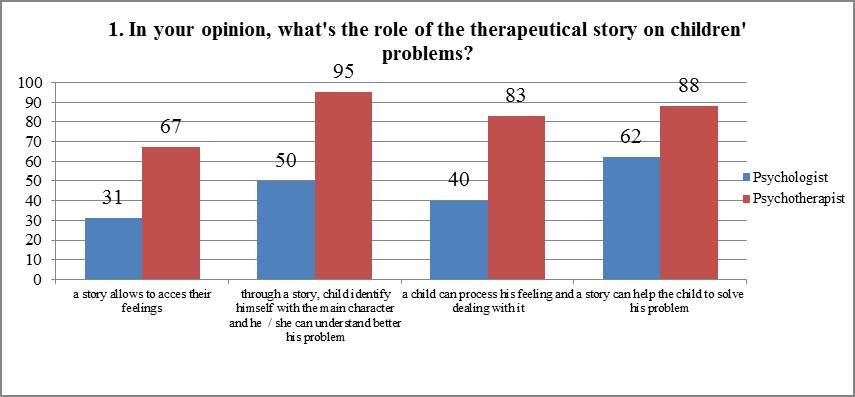
It is very interesting to discover that over 95% of psychotherapists consider that the main role is the
next one: through a story, child identify himself with the main character and he / she can understand
better his problem; instead, over 66 % of psychologists consider that the main role of the
therapeutically story is to help the child to solve his problem. There are significance differences
between psychologists and psychotherapist regarding this issue, which means that psychotherapists and
psychologists see differently the therapeutically story’ role.
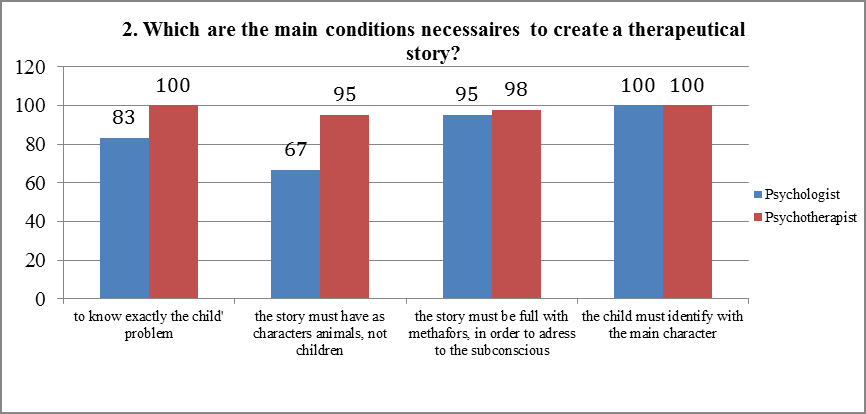
As we can see, 100 % from psychotherapists considers that the main conditions necessary to create a
story are: to know the child’ problems and the child must identify with the main character. 100 % of
the psychologist chose the last option too, which means that there are no differences between
psychologists and psychotherapist regarding this issue.
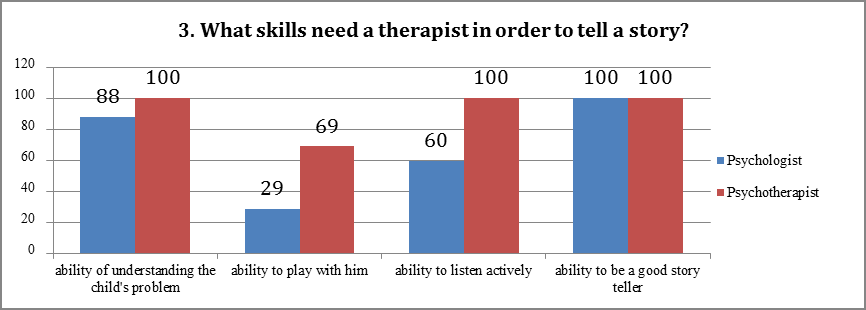
The most important skill for a therapist, according to the psychologists is to be a good story teller
(100 % chose this answer), the psychotherapist have chosen the same skill, but another one too: ability
of understanding the child’ problem (100 % chose both answers).
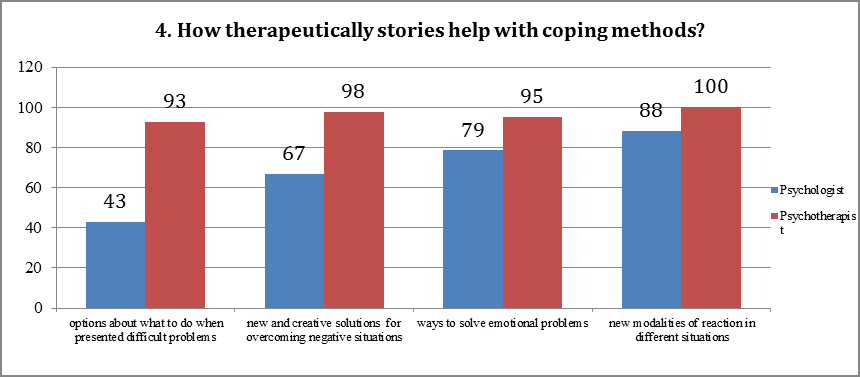
As we can see, 100% of psychotherapists and 88 % of psychologists considers hat a story offers new
modalities of reaction in different situations, which means that a story can really help with coping
methods. A very closed result (98 % of psychotherapists) is related with the fact that a story involves new
and creative solutions for overcoming negative situation, but, we can see that only 67 % of psychologist
are agree with it, so, there are some differences related with the role of the story on coping.

It is quite surprising to see that 95 % of psychotherapists and 74 % of psychologists consider that a
story can really help in anger situation. A very close percent -90 % of psychotherapists and 69 % of
psychologists decided that a story can help in aggressiveness issue too.
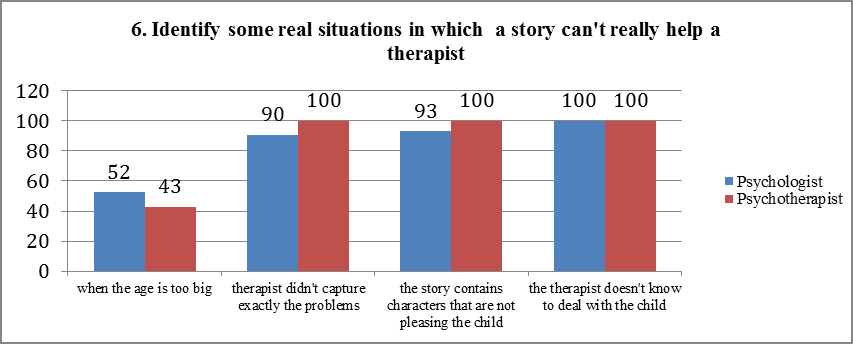
2.7. Validation of the hypothesis
The first hypothesis
therapeutically story to help children to solve their problems.
offered by psychotherapists to the item 1 (more than 88 % consider that a story can solve the child’
problem comparing with only 62 % of psychologists which believe the same thing).
The psychotherapists really believe in the role of the therapeutically story because through a story,
child identify himself with the main character and he / she can understand better his problem.
The second hypothesis “Many specialists will take into account the situations in which they can
use the therapeutically story, neglecting if there are some situations in which the therapeutically
both taking into consideration real situations in which they cannot really help. These situations are:
when the age of the child is too big, when the therapist didn’t capture exactly the problem, the story
contains characters that are not pleasing the child, the therapist doesn't know to deal with the child.
2.8. The main limits of the study
1.sample consists only of psychologists and psychotherapists from Iasi County , so these results
cannot be extended to the entire population of Romanian psychologists and psychotherapists.
2.there will be no pre-testing the subjects, which means that we cannot obtain the accuracy of the
results;
3.there is no control group.
Conclusions and suggestions
As we can see, there are some differences between psychotherapists and psychologists about the
role of therapeutically story in solving child’ problems. The entire sample emphasise the positive role
the story for children. Many of them are aware of the main limits in using the therapeutically story, but,
in the same time, they are aware of the situations or problems which can be solved using it.
In this context, we will try to make some suggestions:
the specialists should follow some courses about writing or telling a therapeutically story;
many of them should use the story more and more in their practice;
the psychologists must know exactly the advantages and disadvantages of using the
therapeutically story;
References
- Pardeck, J.T. (1990). Using bibliotherapy in clinical practice with children. Psychological Reports, 67, 1043-1049. Pinkola-Estes, C. (1992). Women who run with the wolves. New York: Ballantine.
- Rotariu, T., & Iluţ, P. (1997). Ancheta sociologica si sondajul de opinie. Teorie si practica. Iasi: Ed. Polirom.
- p.54;
Copyright information

This work is licensed under a Creative Commons Attribution-NonCommercial-NoDerivatives 4.0 International License.
About this article
Publication Date
04 October 2016
Article Doi
eBook ISBN
978-1-80296-014-3
Publisher
Future Academy
Volume
15
Print ISBN (optional)
-
Edition Number
1st Edition
Pages
1-1115
Subjects
Communication, communication studies, social interaction, moral purpose of education, social purpose of education
Cite this article as:
Turturean, M. (2016). Comparative Analysis towards Therapeutically Story and its Role in Child’ Life. In A. Sandu, T. Ciulei, & A. Frunza (Eds.), Logos Universality Mentality Education Novelty, vol 15. European Proceedings of Social and Behavioural Sciences (pp. 1053-1058). Future Academy. https://doi.org/10.15405/epsbs.2016.09.130

